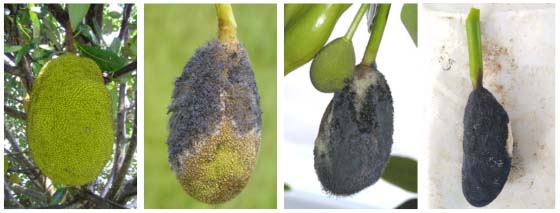What is Soft Rot?
Soft rot diseases are caused by pathogens that secrete enzymes capable of decomposing cell wall structures, thereby destroying the texture of plant tissue—i.e., the plant tissue becomes macerated (soft and watery).
Causal Organism– Rhizopus artocarpi
Symptoms-
- At first soft, watery, brown spots develop on the flowers and fruit. Subsequently, a powdery, fuzzy-looking mass of black spores and white fungal mycelia covers the jackfruit surface.
- With the maturity of fungus, the sporangia produce spores and turns brownish black.
- Young fruits, if affected, mummifies & result in premature shedding.
- Fruit symptoms can appear on the tree or can develop on fruit that are in storage or transit.

Left: healthy, maturity jackfruit; Centre & Right: young jackfruits with Rhizopus rot
Mode of spread-
This disease spreads via –
- Wind
- Rain
- Tiny fungal spores deposited on moist fruit surfaces, the spores germinate, and infective mycelia grow into the tissues.
Management-
| Cultural Method | Chemical Control |
| Remove and destroy diseased fruit from trees and the ground. Clean up decaying organic debris within and around the tree.Keep ripe fruit from contact with the soil or decaying organic material.Avoid waterlogging around the root zone. | Spray Copper Oxychloride (COC) @ 2g/litre at an interval of 10 days.Foliar spray: Metalaxyl 8% + Mancozeb 64% WP @2g/litre.Carbendazim 50% WP @2g/litre. |
References –
- https://niphm.gov.in/IPMPackages/Jackfruit.pdf
- http://ecoursesonline.iasri.res.in/mod/page/view.php?id=9054
- https://www.ctahr.hawaii.edu/oc/freepubs/pdf/PD-29.pdf#:~:text=Jackfruit%2C%20Artocarpus%20heterophyllus%2C%20is%20a%20popu-%20lar%20garden,fungal%20disease%20of%20jack-%20fruit%20flowers%20and%20fruit.
- https://www.researchgate.net/publication/328674963_Soft_rot_of_Jackfruit_Artocarpus_heterophyllus_by_Rhizopus_artocarpi_Berk_Broome_Boedijn_in_Andhra_Pradesh_India
- Image source: https://www.ctahr.hawaii.edu/oc/freepubs/pdf/PD-29.pdf








